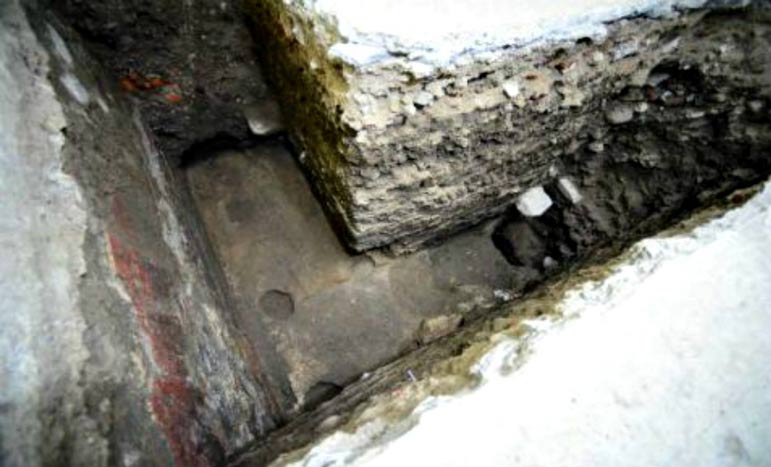Tunnel to Two Previously Unknown Chambers Found in Mexican Temple Mayor
In February 1978, a group of workers from an electrical company located a monumental sculpture in the middle of Mexico City. Its discovery and excavation marked a before and after in the study of Mexican culture.
From that moment, the authorities decided to create the Templo Mayor Project. A project through which it has been possible to conduct the study of the main building of the ancient Aztecs/Mexicas as well as other important structures that made up the ceremonial center of Tenochtitlan, an area also known as the Sacred Precinct.
Introducing the New Finding
Since its founding by Eduardo Matos Moctezuma, the on-site investigation has been continuous and there have been many discoveries. The result of the sustained research is the new finding, consisting of a narrow corridor leading to the center of the circular platform known as the Cuauhxicalco. This tunnel also leads to two lateral chambers, in which archaeologists suspect there could be the remains of some important Mexica rulers.
On November 30, researchers of the Temple Mayor Project (PTM) and the Urban Archaeology Program (PAU), participated in the first roundtable of the Tenochtitlan at the foot of the Temple Mayor: Excavations and recent studies. It was Leonardo López Luján, director of the last five seasons of excavations of the PTM, who announced the recent discovery of a tunnel 8.38 meters (27.5 feet) long, 45 centimeters (17.7 inches) wide, and a half meter (1.6 feet) tall, which leads to the center of the Cuauhxicalco: a circular structure in which, according to historical sources, the bodies of Tlatoanis (kings or speakers) were cremated.

Detail of the Cuauhxicalco: a structure in which, according to historical sources, the bodies of tlatoanis (kings) were cremated. It is also the location of the newly discovered tunnel. ( Miriam G. Marín C. / MTM-INAH)
History of the Discovery
According to information published by El Sol de Mexico, during the 2013 excavations on the north side of the Cuauhxicalco, members of the PTM discovered a heavy slab of andesite. After moving the three-ton slab, they found a large container meant for offerings, which had been filled by the stones of a torn down wall.
- Sacrificial gifts found at Aztec Temple in Mexico feature a trove of diverse species
- Archaeologists unearth Aztec human skull trophy rack in Mexico temple
- Dark Mysteries of the Deep: Ancient Divers and their Dangerous Journeys
- The Aztec Calendar Wheel and the Philosophy of Time
Inside they also discovered skeletal remains belonging to children between 5 and 7 years old, a couple of skulls along with their first three cervical vertebrae, and the bones of one hand and two feet. Additionally, there were braziers, sacrificial knives, bones of an eagle and golden artifacts.

The discovery was made public November 30, during the first round table of the "Tenochtitlan at the foot of the Temple Mayor: Excavations and recent studies." (OEMENLINEA)
However, the archaeologist Tomas Cruz also noticed that the south wall appeared to conceal a passage. This is how López Luján described the situation:
"By releasing some of the earth and stone, we learned that the passage led directly to the heart of Cuauhxicalco. Inside there were two masonry walls that seemed to seal two old access points. From what sources say about the Cuauhxicalco, it was a funerary building, which led us to speculate that behind these walls there may be two small rooms which could contain the cremated remains of some Tenochca rulers, perhaps even Moctezuma I and his successors, Axáyacatl and Tizoc, considering the construction phases reflected in the building."
For her part, the director of the National Institute of Anthropology and History (INAH), Teresa Franco, remarked that the capital of the ancient Mexica empire continues to be researched and analyzed by members of the archaeological programs in excavations in much of the Sacred Precinct.

Carved ashlar of the Cuauhxicalco, Temple Mayor, Mexico City. (Miriam G. Marín C. / MTM-INAH)
She also could not help but recall the events of February 1978, when the discovery led by Matos Moctezuma provoked a change of form and substance to the archaeological investigations carried out in the center of Mexico City. 38 years later, in the exploration of the double pyramid dedicated to the gods Huitzilopochtli and Tlaloc:
"In total the research has found more than thirty religious buildings, constructions which are associated with small shrines, sculptures, paintings, murals, and offerings that have enriched the patrimonial heritage of the Mexican people.”
Excavations on the tunnel and the chambers will continue in 2016.
Featured image: Part of the newly discovered tunnel. (Notimex / 24-horas.mx)
Author: Mariló TA
This article was first published in Spanish at https://www.ancient-origins.es/noticias-historia-arqueologia/descubierto-t%C3%BAnel-templo-mayor-m%C3%A9xico-que-conduce-dos-nuevas-c%C3%A1maras-subterr%C3%A1neas-003129#sthash.1oLQaUUj.dpuf and has been translated with permission.



















